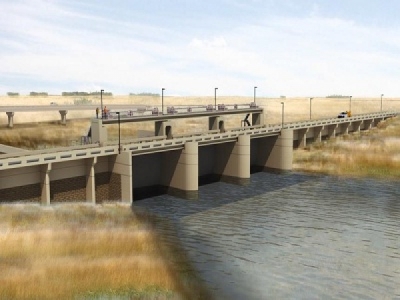
Posted on August 16, 2016
By Tu-Uyen Tran, Inforum
The city and Cass County are borrowing $200 million in anticipation of upcoming expenses of building the Red River flood diversion.
Commissioners from the two local governments agreed earlier to each borrow $100 million from Wells Fargo and to help one another pay off the debt should one find itself short. The Fargo-Moorhead Diversion Authority, of which both are members, agreed to the arrangement Thursday, Aug. 11.
John Shockley, an attorney for the authority, said half the money is to refinance an existing $100 million U.S. Bank loan on better terms. The other half is for “liquidity purposes,” he said, meaning having cash on hand for various project needs.
This includes land purchases and the cost-share required by the U.S. Army Corps of Engineers.
The total project cost is $2.2 billion with the federal government footing $450 million, adjustable for inflation.
Bonds vs. loans
The Diversion Authority has said it intends to finance the project with bonds in the long run but Cass County Auditor Mike Montplaisir said bank loans are the best short-term financing option.
He said the county and city will get “fantastic interest” on the loans at less than 1 percent. They got the same deal from U.S. Bank but the bank put additional conditions for borrowing another $100 million, which Wells Fargo didn’t require, he said. Since U.S. Bank has a lien on the city’s and county’s sales tax revenue, it was necessary to pay off that debt and start fresh with Wells Fargo, he said.
In the long run, additional borrowing from banks wouldn’t be an option despite the low interest, he said, because even major banks would not want to carry that much in their books. Bonds are resellable so the risk can be spread out over many investors, he said.
Once project costs are more defined — construction bids aren’t in yet — bonds will make more sense, he said, though if interest rates threaten to go up, it might make sense to issue bonds to lock in the low rates.
The bonds, to be repaid with city and county sales taxes, would be used to refinance the bank loans.
Minnesota diversion
Of the $100 million in new money, $58 million will go to the U.S. Army Corps of Engineers as part of the non-federal share of the estimated $2.2 billion project. A project agreement the corps signed with the Diversion Authority states the share is $65 million, but the Diversion Authority earlier paid $7 million.
The total amount non-federal project sponsors, meaning the authority, will have to pay is actually much larger — about $1.4 billion or whatever the government won’t pay — but the $58 million is based on a specific corps requirement that non-federal sponsors of its projects pay 5 percent of the project cost.
Oddly enough, that 5 percent is not the cost of the diversion to be built in North Dakota but the estimated cost of an earlier diversion the corps wanted to build in Minnesota, Army Corps Project Manager Terry Williams said.
Minnesota officials didn’t want their residents to feel the impact of a project that mostly protects North Dakota cities, so the Diversion Authority urged the corps to put the diversion in North Dakota, which increased the cost.
Source: Inforum





